Create a Print-Rich Environment with Labels that Promote Literacy
A print-rich environment can boost literacy, and labeling the home can help children to associate words with a real object. If a child can name an object verbally, then they can automatically “read” the word labeled on an object.
However, a label’s appearance is paramount to its effectiveness. Parents and teachers often think that they need to get fancy or cute labels for kids.
In reality, simple is best. If the purpose of the label is to teach a child to read, additional colors and designs may compete with the text. In other words, a label with too much information may confuse children.
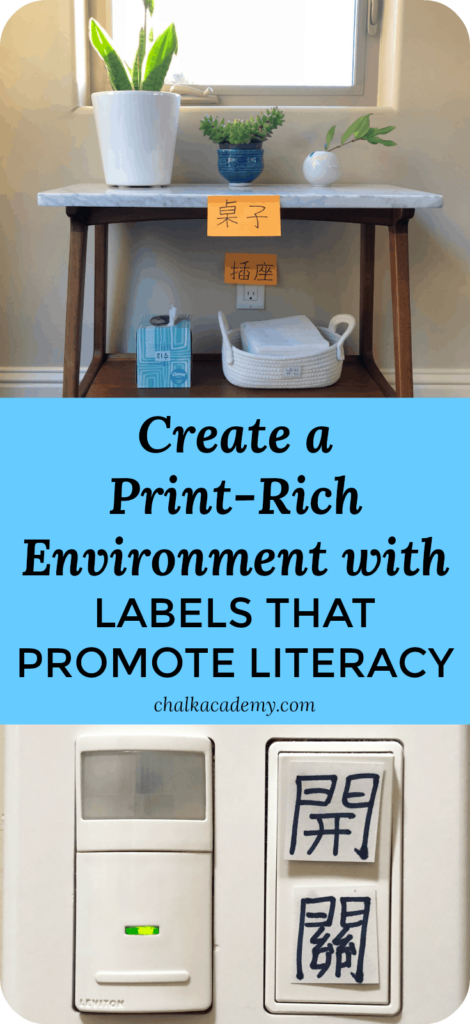
Chalk Academy is reader-supported. Some of the links are affiliate links. When you buy something through an affiliate link, we may earn a very small commission at no cost to you. Details here.
This post is part of a series dedicated to teaching kids how to read Chinese, although many principles apply to other languages.
- When and How to Introduce Chinese Characters to Kids?
- 15 Ways to Encourage Your Child to Read
- Memorize Chinese Characters with 5 Key Steps
- Create a Print-Rich Environment with Labels that Promote Literacy
- How I Taught My Daughter to Read 1000+ Chinese Characters as a Non-Fluent Parent
Creating a print-rich environment: What does the ideal classroom or homeschool label look like?
An effective print-rich environment is organized with easy-to-read print. The meaning of the print should also be obvious. Advice from various visual experts, including the American Foundation for the Blind and the website builder, Wix, agree on the following points:
- Bigger is usually better (as long as it’s not too big)
- Text color must contrast from the background (dark text with light background)
- Avoid decorative fonts
Obviously, children can still learn if the aforementioned criteria are not met. My daughter learned the English alphabet with colorful blocks, and she can read cartoonish Chinese font that I cannot decipher. You may also know of children who excel in heavily adorned classrooms.
However, many kids struggle with reading and are often distracted and overwhelmed by the environment. Ultimately, an effective label should require minimal cognitive effort in decoding and remembering the text.
Supplies to create labels for a print-rich environment
If you can write Chinese:
- Black Sharpie marker
- Light-colored writing surface:
- Post-It 1″ labeling & cover-up tape
- Painter’s tape
- White index cards
- Avery address labels
- Large full adhesive Post-It note
If you cannot write Chinese or don’t have time to write:
If you want to create labels to learn a new language but cannot write them, you will need printed labels with black ink. For Chinese, a brush-style font like KaiTi is recommended so that the start and end of each stroke are visible.
- Download our printable labels in simplified Chinese, traditional Chinese, Pinyin, Zhuyin, and/or English.
- Consider a multilingual label maker.
Pros and cons of handwriting labels
Benefits
If you have decent Chinese handwriting, writing labels is a great way to model the importance of writing to children. Writing can increase print awareness by showing exactly how the text is created.
Although I am familiar with stroke order, I cannot remember many Chinese characters and frequently refer to my dictionary. While I have occasionally made mistakes, most of the time, I am copying correctly. Writing helps me practice Chinese characters as an adult learner.
Downsides
If you have messy handwriting or your child remembers better with consistent type fonts, printed labels may be better for learning purposes.
Print-rich environment: Examples of clear labels that promote reading
Since my children are learning Chinese and Korean as minority languages, the primary goal of my home labels is to encourage the recognition of Chinese and Korean characters.
Bigger is better for highlighting the target language
Since my family’s main language is English, and everything we own already has factory labels in English, I don’t bother writing the English words.
My goal is for my kids to see as much of their minority language as possible. Therefore, I cover the brand names with a large white sheet of paper and secure it with clear packaging tape.
Here are examples of bottles labeled in simplified Chinese with a black Sharpie marker. In the image below, the Chinese characters are more noticeable than the English words.

Use a clean, white background behind words
White is the best background because it provides the best contrast. However, I don’t want to encourage paper waste, so if you have other paper colors that you need to use, by all means, use them!
While multiple colors can be overstimulating and distracting, a pop of color can be attractive and provoke curiosity. Our largest Post-It notes are orange, so I used that color for the recent labels in this post.
We have smaller Post-It notes of various colors, but I try to use only one color so my kids are not overstimulated. Some may consider orange too bright and prefer a muted color.
Take home point: make sure the words are visible with a black marker and adequate contrast!
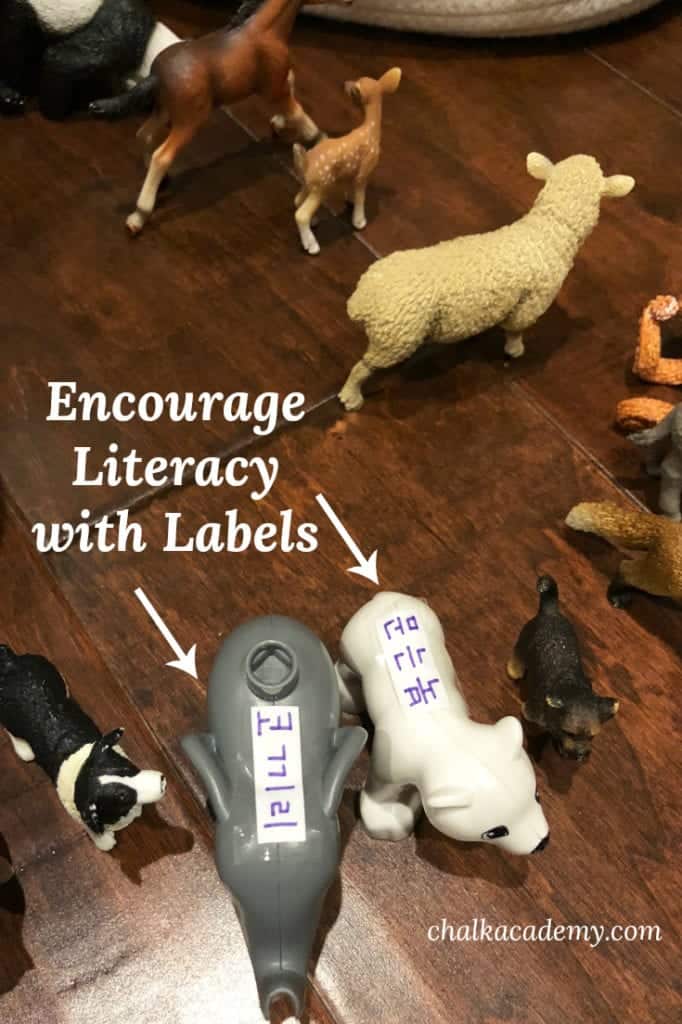
Make sure that the correct object is labeled
This might seem obvious to parents and teachers who are labeling, but is the label intuitive for the child?
For example, if you put a label 杯子 (bēizi / cup) on a table next to a cup, your child could associate 杯子 with a table instead of a cup. However, if you put the label directly on the cup, it is obvious that 杯子 refers to the cup.
Skip the clip art in your print-rich environment
I don’t bother adding an illustration since the label is directly on the object. My kids know that the bottle above contains 枫糖浆 (fēng tángjiāng / maple syrup) simply by looking at the bottle.
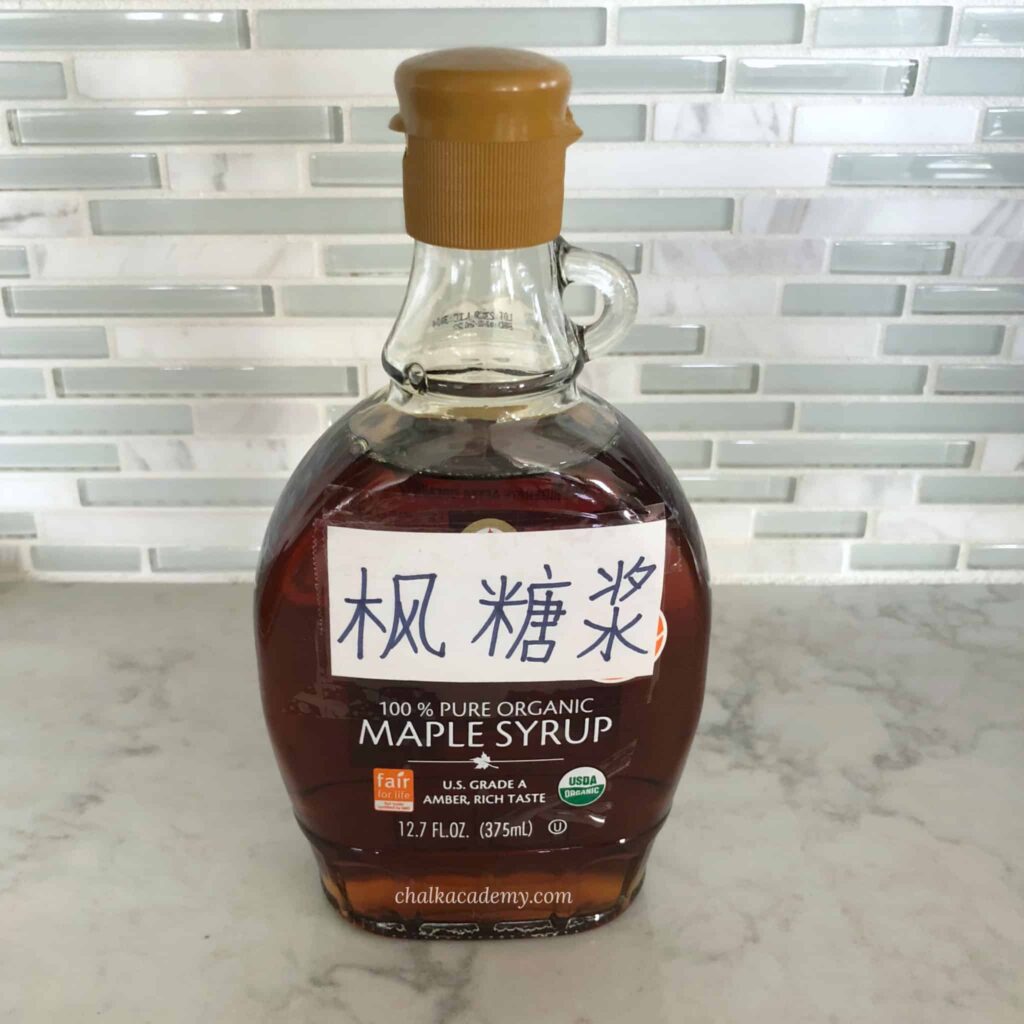
All too often, I see clipart on word labels. Images are often unnecessary, redundant, and distracting from the text and physical object.
Make labeling an interactive activity!
Involve your child with labeling certain items around the house! Turn this into a game by calling out the word and having kids race to put a labeled Post-It note on the correct item! If kids have fun finding the correct object, this interaction can help them remember spoken and written words.
In addition, labels can be used as:
- Flashcards for review
- Other reading games in the target language
Create a print-rich environment with word walls
Occasionally, I create a Post-It note “word walls” in our house when my daughter needs extra review. In addition, visual cues can serve as a reminder to speak the target language.
Since my daughter sometimes forgets the Chinese character for “wall”, she once asked me to post 墙 / 牆 (qiáng / wall) on the wall. When she first learned to read Chinese years ago, I would have just written 墙 or 牆 for simplicity. Now, my daughter can handle multiple characters simultaneously, so I can include related words.

Rotate labels in your print-rich environment
When people have gotten used to seeing something, they might tune it out since it’s no longer fresh and exciting.
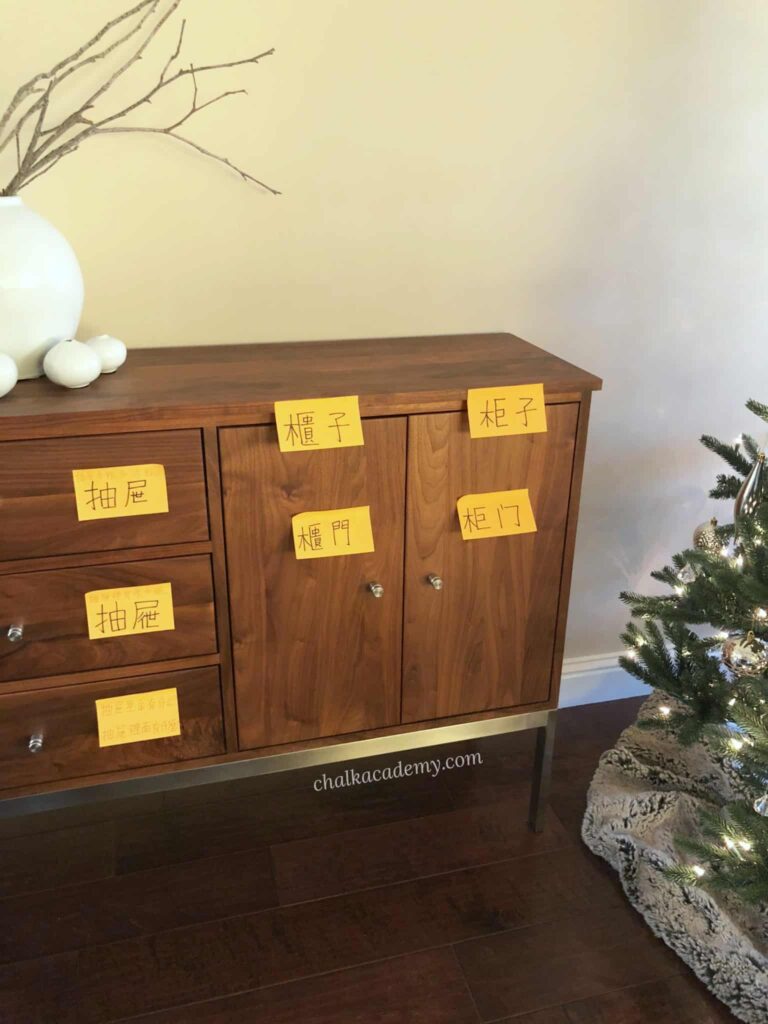
Since I want my kids to notice what I write, I put up only a few at a time and write more labels later.
Avoid extraneous other text
Many parents like me cannot speak or read Chinese well and rely on phonetic support from Pinyin or Zhuyin. Write the phonetic spelling very small and away from the main text if needed. Use a lighter color to be less prominent from the target word. Keep in mind that your home is likely saturated with other words.
Include other text only when relevant and not overwhelming
Since my oldest child reads fluently for her age, sometimes I pencil or pen in additional text for reading practice.
For example, 抽屉 / 抽屜 (chōutì / drawer) is not frequently encountered in our story books, so my daughter sometimes forgets these characters. Thus, I wanted to ensure these key characters were large and in charge with my black Sharpie. I also wrote short sentences featuring the key characters in context with a regular pen for reading practice.
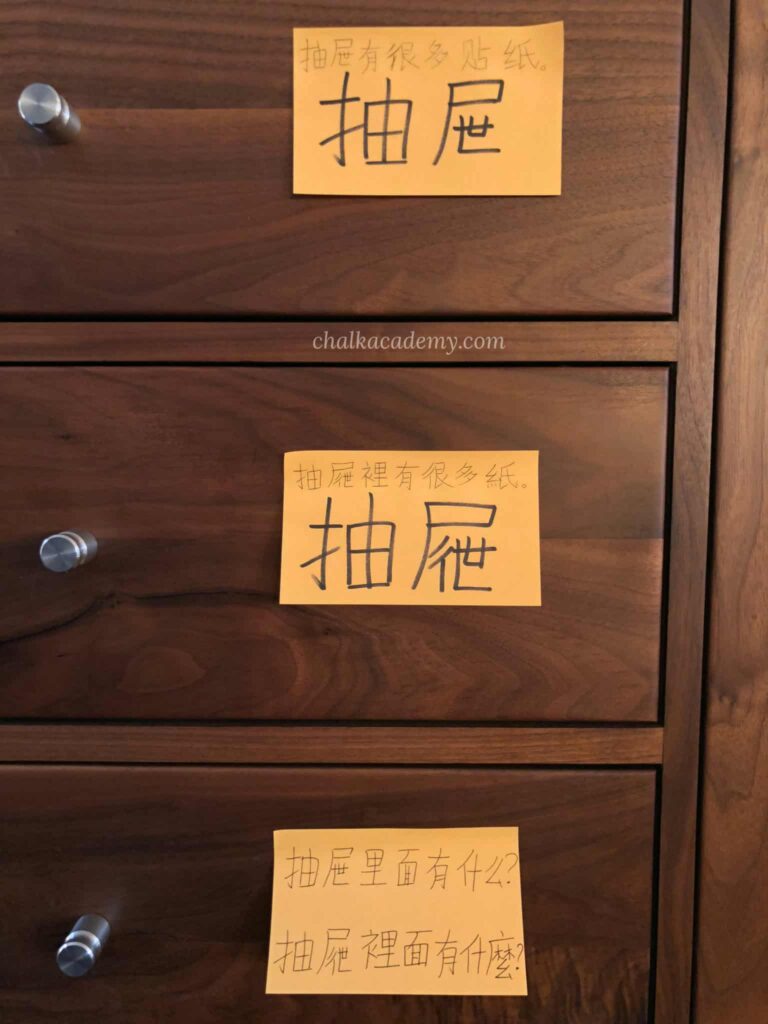
What about labels in more than one language?
My daughter is learning to read Chinese, Korean, and English simultaneously. When she first learned to read, I generally kept each language on separate sheets of paper to minimize distractions during information processing and recall. Now that she has a solid foundation in Chinese, I am not concerned about her being distracted by English.
English and Chinese labels
Above is an example of English and Chinese art and school supplies labels. As my husband often forgets where things are located throughout the house, from a practical standpoint, we need labels in English for organization.
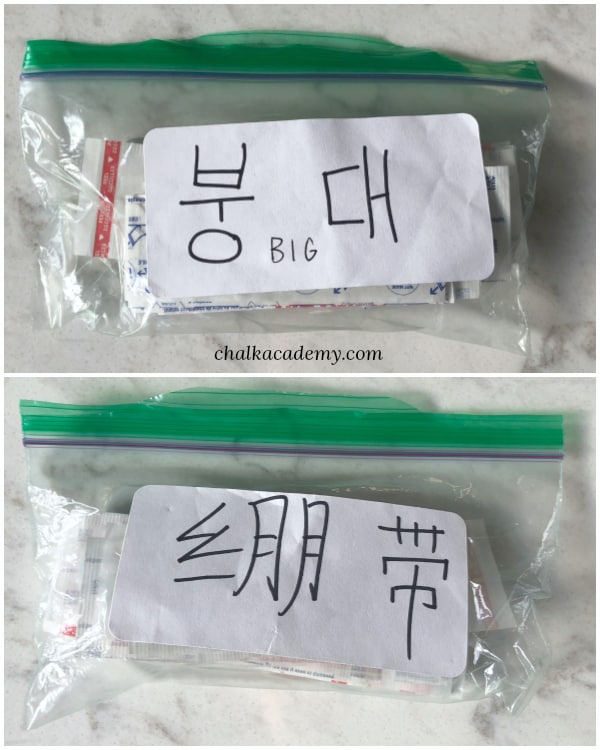
Chinese and Korean labels
This example shows bandage labels in Chinese and Korean on opposite sides of a storage bag. The Korean label is suboptimal because of the random English words written between the Korean characters. This is not a big deal for my daughter, who can read each of these languages, but it is disorganized for a new reader. Ideally, “big bandaids” should be written in Korean with proper grammar.

Simplified Chinese and traditional Chinese labels
In this example, I labeled light switches in simplified and traditional Chinese characters to introduce both scripts.
Since I want to write the Chinese characters as large as possible, there is no room to fit both scripts. However, my children can infer they have the same meaning, given the identical label position on different light switches.
When space permits, I put two labels beside each other on different Post-It notes, such as with 灯 and 燈 (dēng / lamp), so my children can compare the characters.
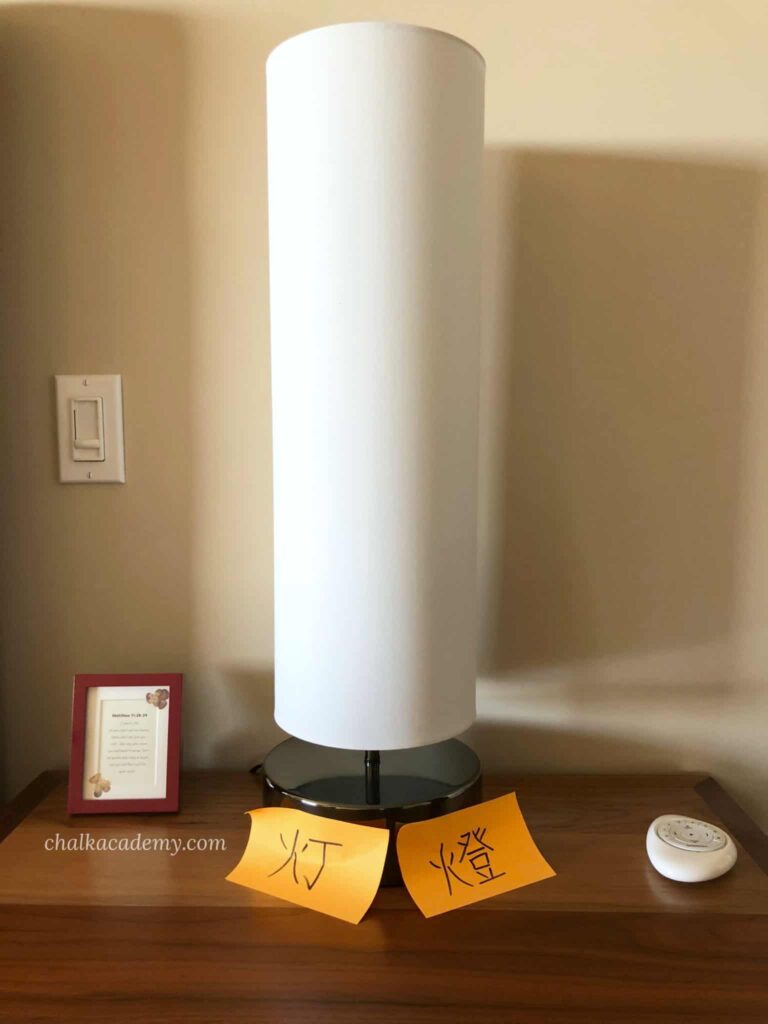
Creating a print-rich environment: Comparison of different labels
Which language stands out?
In the photo below, the Chinese characters on the Post-Its grab your attention.
However, did you notice Korean labels on the tissue box and basket? Perhaps not at first glance because the Korean letters are small.
In contrast, you can see the Chinese characters from a distance. This is not to say that small labels are always bad. My daughter thinks they are “cute!” Whether she notices them is questionable, so consider size and color when creating labels.
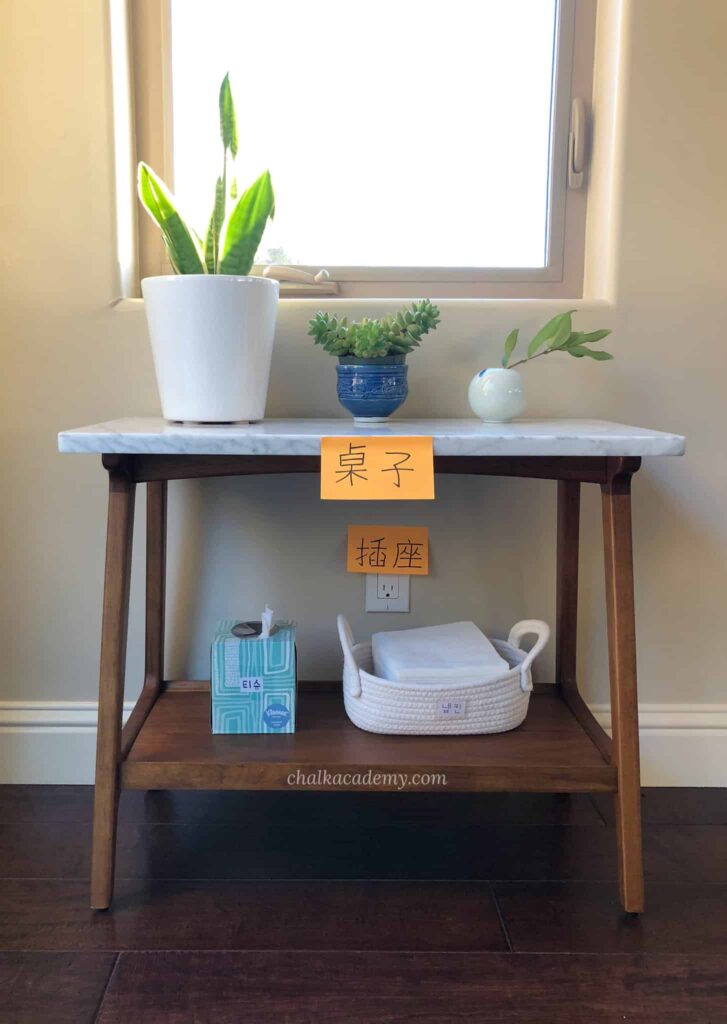
Store-bought labels
When I first began to learn Chinese with my daughter a few years ago, I purchased several labels from Amazon. They had large Chinese words and tiny Pinyin letters. My daughter was instantly attracted to the cute, simple pictures.

At that time, I bought them because I was not comfortable with writing Chinese. But my husband did not like the look of these around the house and kept taking them down. They are difficult to remove, and you can’t reuse them.
In hindsight, my Post-It note method has been much more effective because the Chinese characters are the clear focus. Post-It notes are cheap, and you can repurpose them for learning games, as mentioned above.
In summary, we have created an effective, print-rich environment with plain white sheets of paper and Post-It notes. Each word is visible, often from a distance. No decorations or illustrations are needed. Save those creative urges for other projects!
Has your family tried using labels to create a print-rich environment?
Do you label your home with keywords? If so, have labels helped your children learn new words? Please share in the comments below!
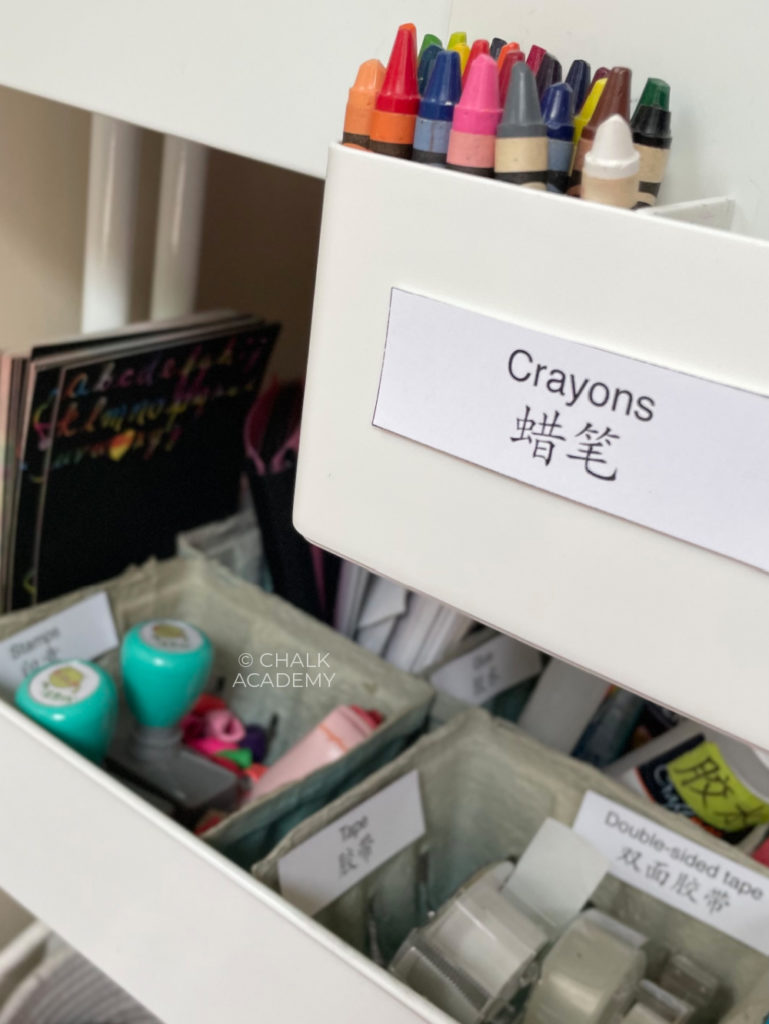
At what age do you recommend introducing labels? My daughter is currently 2.5.
Hi! Great question. I think sometime during the toddler years is a great time to introduce labels and normalize the language visually around the home. It might be too young for most kids to read most of the words, but it makes Chinese characters less “foreign”, if that makes sense. And you might be surprise at what words she might pick up. To save time, I created some printable bilingual (Chinese/English) labels here.
Hi Betty, my son hasn’t even mastered his ABC. I would also like him to learn Chinese at the same time. Would having both languages in each label be confusing or too overwhelming?